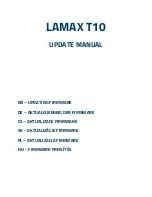
User manual // Speed Max
HENSEL-VISIT GmbH & Co. KG
21
Flash Check
Activating this option via pushbutton
13
will make the
modeling lamp go off after each flash discharge. This is to
signal that the flash unit has fired. The lamp will come
back on when the ready state is attained. The flash check
assures that all units in a given setup were reliably
triggered.
Allocation of Identification Number for Interface
RS485
A dedicated identification number can be allocated to
each Speed Max via pushbutton
7
. This ID number is
shown in the small green 2-digit display
6
above the
pushbutton switch.
Each time button
7
is pushed the ID number will be raised
by one. Numbering starts at 00. After number 09 the
number 00 will show again. By allocating a dedicated ID
number to each flash unit it will be possible to selectively
access that unit by means of the RS485 interface.
USB Socket
The USB socket
20
of the Speed Max can be connected
to a USB port of a computer for transferring firmware or
for programming purposes. To start the boot loader mode
the Speed Max must be first powered off, then all three
buttons PROP, AUDIO and SLAVE must be pushed and
held at the same time, and while doing that the unit must
be turned on. If the flash unit is getting connected to the
computer for the first time the computer screen will display
"new hardware was found" and the necessary drivers will
be installed automatically. While in the programming
mode LEDs and displays on the Speed Max go dark, all
except the big green READY LED which will flash
intermittently.
TTL Input
The TTL-input jack
21
can be used to connect the Speed
Max to a signal generator for triggering flash discharges.
The "TTL" designation stands here for "transistor-
transistor-logic" and describes standardized properties of
signals used in logic circuits. This signal "TTL" should not
be mistaken for the term "through the lens" found in
photographic applications.
13:
FC
6, 7:
ID
20:
USB
21:
TTL












































